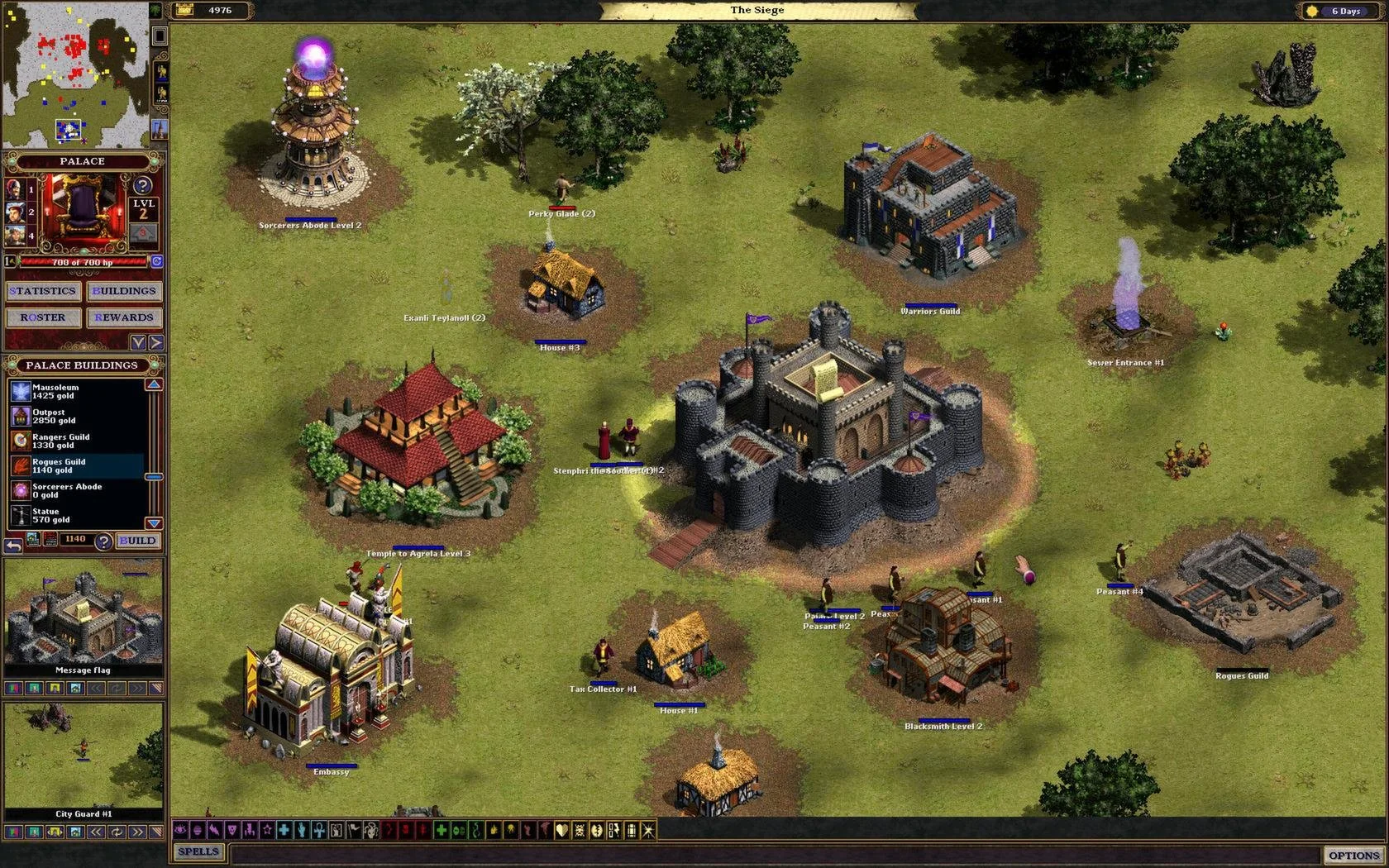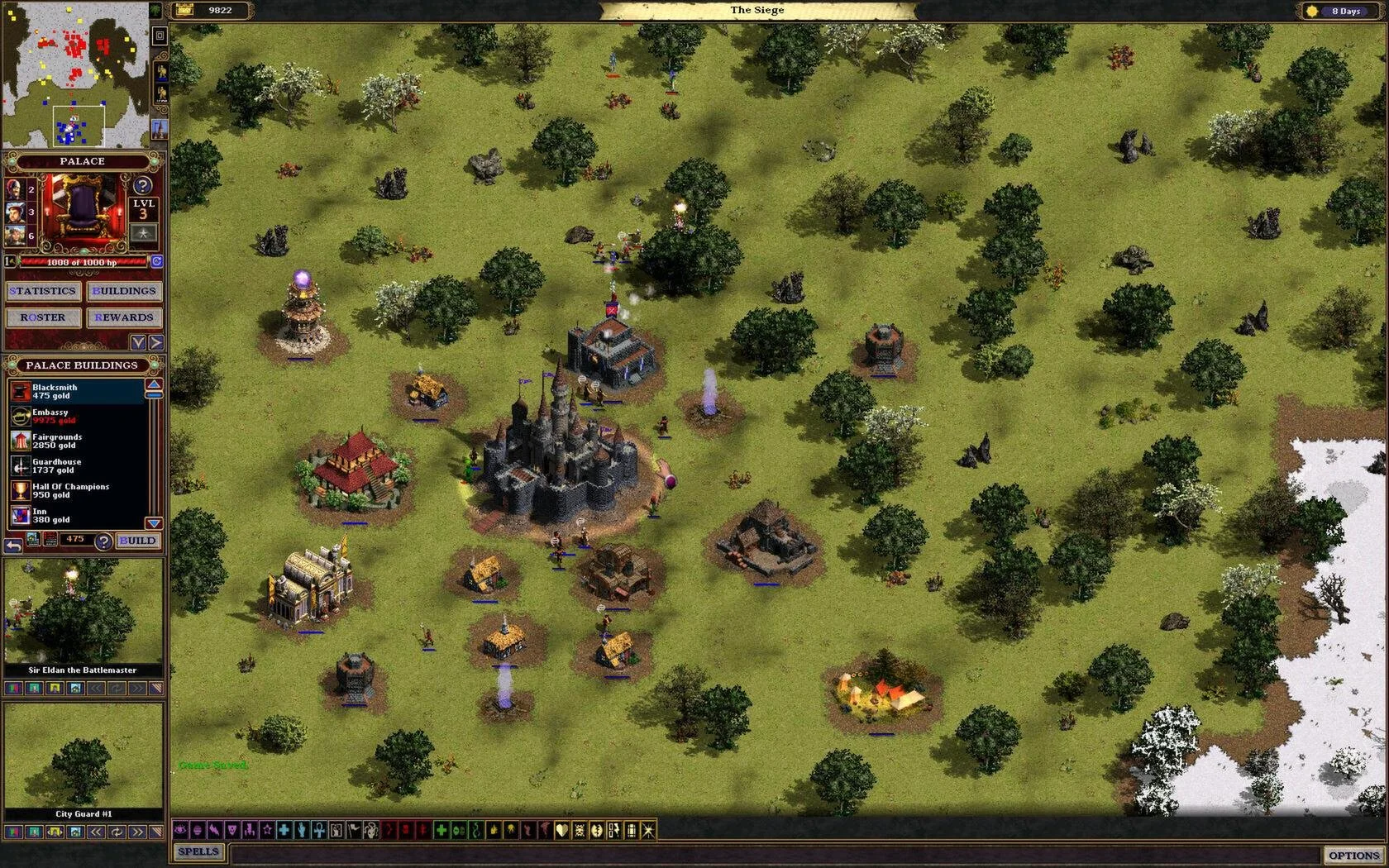Game Design Perspective: Majesty
In the simpler times of 2000, I first discovered Majesty. The game entranced me. I spent countless hours training up your standard DnD archetypes (ranger, fighter, wizard, druid) from zero to hero. It's one of those games that's stuck with me for so long, simply because there hasn't been much else like it. Not for a lack of trying on my part. I tried to create a coffee-break version Majesty called Within a Dead City, and I'll be drawing on the lessons I learned for this article. Nothing like trying to recreate something from scratch to help you understand how it ticks
The top RTS's of the day, such as Starcraft, were extremely focused on the strategy aspect of managing a base, optimizing a build order, and leading squads of individual units into battle. Majesty kept some of the trappings of that genre - namely the base building and research aspects - but focused instead on the individual units. You were not able to direct a group of heroes to attack any given building. In fact, you could barely direct them to do anything. Instead of issuing direct orders, you could only appeal to their greed and place a bounty on a monster or a den of evil. With a great enough reward and greedy enough heroes, even the greenest thief would try to take on a dragon.
This created an interesting dynamic in the game, as gold was the only currency in the game. Even spells cost money instead of mana! Getting gold, therefore, was the primary objective for the player. There were two main ways this would happen: tax and trade. Tax collectors would roam around the player's base, collecting small amounts of passive income from nearby houses. Tax collectors would also collect money from the shops frequented by your heroes. In that way, the money that your heroes earned would eventually trickle back into your economy.
These income streams were all well and good, but the demand curve of how much money you needed would quickly outstrip the supply curve of tax collection. In order to succeed at most missions, you need to set up trading posts far away from your heavily-defended main base. These trading posts would send vulnerable trading caravans back to your market. The greater the distance travelled, the greater the money gained. Distant trading posts were harder to defend, though, as the distance greatly increased the travel time - both for heroes (to defend the trading posts) and peasants (to repair the damage done). There was good risk-vs-reward pull just in deciding where to place trading posts.
If travel time seems like it plays a significant part in the game, it certainly does. Heroes move slowly, and your carefully constructed base grows more unwieldy as you expand radially outward from your castle. Enemies are likewise slow. The game makes up for this by densely populating enemy lairs throughout the map. These lairs serve as spawn points for enemy monsters and focal points for your territorial expansion and conquest. Clearing out nearby monster lairs is almost a prerequisite for setting up a profitable trade route. Majesty plays slowly in some ways - a little bit plodding, even. This pacing fits well with the simulation aspect. Outside of spells, your attention (or lack thereof) will rarely decide whether a mission succeeds or fails. You paint in broad strokes, so to speak. You can leave your heroes alone for a time and expect them to survive. This also gives them time and space to surprise you, while your attention could be focused elsewhere.
Where is your attention, then? The larger economy. Do you have enough gold coming in? Are your tax collectors getting ganked by the auto-spawning sewers, which also contribute to your base's sprawl? Do you spend money on spells to help a hero through a tough fight, or is the new trading post a higher priority? Do you have enough shops set up and gear researched for your heroes to spend their gold?
Finally, different hero classes all have different behaviors based on fantasy genre expectations. Rangers like to explore the wilderness. Warriors like to get better armor and fight enemies. Rogues will fight any opponent for a price, and will steal from other heroes. Wizards are hilariously overconfident and frequently bite off more than they can chew, meeting a quick demise. Although every warrior and every wizard might follow the same scripted per-class behaviors, the interplay between the classes is entertaining enough to keep it feeling fresh. Additionally, the player must choose between higher-level tiers of hero classes. No healers hanging out with necromancers, for instance. This helps add a little variety to different missions, as there are twelve different combinations of hero guilds to choose from.
There things that Majesty does great - the ant-farm feeling of having a roster of powerful heroes, watching heroes grow from zeroes to world-beaters, figuring out where to direct your attention and your money. At the same time, Majesty felt limited in some ways. High level heroes are quite powerful, and a team of them can make mincemeat of any monsters the game throws at you. Great when you get them, but that also means that the game's campaign missions are focused more on the initial build up. The tension and the question of failure are front-loaded in the mission. Once your heroes reach a high-level, that tension is diminished or gone completely. On one hand, this is all part and parcel of an RTS game. You wouldn't expect a game of Starcraft to last five hours. On the other hand, it always felt like a bit of a bummer to leave your heroes behind on a map and have to start a new map with new heroes.
What might seem like an easy solution - provide higher level monsters farther out from the base on a larger map, making for longer games - runs up against the game's pace and space. Your heroes don't get quicker when they level up, and they'll still plod along the map. Going out farther takes more time, and they'll have to cover more ground as the area to patrol and explore grows quickly. (Mathematically: a circle with a radius three times as larger as another has nine times the area.) In some ways, the game's spacing (in terms of map size) feels like the right size for its power curve, and pushing it farther wouldn’t feel right.
As discussed, you expand outwards from your castle. This means that monster lairs close to your starting location tend to be lower level and higher level lairs tend to be farther away. As your first batch of rookie heroes clears out the nearby lairs, they gain valuable gold and experience. This presents a game design problem - what happens if one of your highest-level heroes dies? You can train a rookie Level 1 hero to replace them, but experience and levels from clearing out nearby low-level lairs are no longer obtainable. Majesty tries two things here to help, one more interesting than the other. The less interesting way is through the Fairgrounds building. This building allows all heroes to participate in a tournament, netting them enough experience to hit a useful mid-level fairly quickly. The more interesting way is through spawning Sewer monster lairs as your kingdom grows larger. These spawn randomly near your base, cannot be destroyed, and will spawn Ratmen that will steal, pillage, and murder your tax collectors. Larger bases usually have a problematic Sewer or two, and possibly a zombie-spawning graveyard to boot. While these complicate base-building efforts, they also ensure that fresh heroes have a steady stream of enemies to fight and gain those vital first few levels.
There's an interesting failure of Majesty to meet genre expectations. Your heroes in Majesty are very much lone wolves. Typically, they only team up when there's a juicy bounty laid out for them. (There are some exceptions, such as barbarians wanting to chill with rangers.) This works well enough for the game's purposes, but it can be frustrating for players when their heroes trickle in, one by one, and get ganked by the uberwizard. (Those slow travel times again!) "Man," the player thinks, "I bet my heroes would have taken that warlock out if they coordinated and all attacked at the same time." Due to the influence of Dungeons and Dragons and its ilk, there's a fantasy expectation that heroes party up and work towards a common goal. One of the most common complaints from Majesty fans is that they wish they could form parties of heroes. As we'll see in future articles, this is an issue that nearly every successor tries to address.
One final weakness of Majesty, in my opinion, was that your heroes' lives felt quite limited. They were downright two-dimensional, as far as any characterization goes. There's little to no 'home life' for the heroes, and almost all of their actions are focused around banging on things with swords. Exploration? Reveals more lairs and monsters to fight. Buying things at the shop? Better armor for the next fight. Training at the Fairgrounds? More experience for fighting. There wasn't a lot of downtime activities, and those that were present were almost viewed through a capitalist or moralist lens. (Are your heroes spending too much time gambling away gold at the Elven Lounge? They should be out there fighting instead!) Perhaps it's asking too much of the game (or, indeed, asking too much of the genre) for that an interesting 'home life'. Other RTS's of the day didn't even have individual names for their units.
Maybe that's what made Majesty stand out so much when it first came out. Its game systems, while rudimentary compared to something like Rimworld, hinted at a richer inner life for your units. In other games, units were mindless drones, doing what you want, moving where you want, and attacking what you want. They don't think twice about being sent on a suicidal attack against heavily-fortified defenses. In Majesty, you have to spend time figuring out what the heroes want. That in itself is a small revolution.







